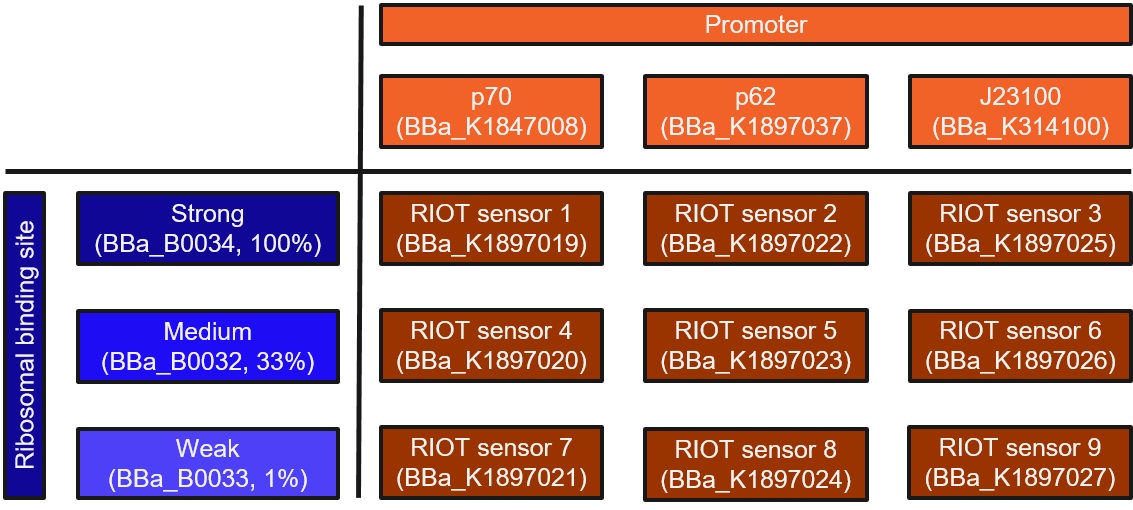Difference between revisions of "Part:BBa K1897019"
Phuongnguyen (Talk | contribs) |
Phuongnguyen (Talk | contribs) |
||
| Line 6: | Line 6: | ||
| − | <!-- Add more about the biology of this part here | + | <!-- Add more about the biology of this part here --> |
| − | + | <h1>Usage and Biology</h1> | |
| + | <p>This is RIOT sensor 1 which belongs to the RIOT sensor collection (BBa_K1897019-BBa_K1897027) and was designed to detect the increased level of L-lactate produced by tumor cells in the microenviroment. A lactate sensitive promoter obtained from 2015 ETH Zurich team was used as starting material. Our designed sensor has to be extremely sensitive to small changes in lactate concentration. This means that our sensor needs to have no basal expression and significant increase in reporter output (Alanine Racemase, ALR) in the presence of lactate. ALR is required for synthesis of D-alanine, an essential amino acid for bacterial survival [1].</p> | ||
| + | <p>We minimise the basal expression of our reporter by linking different strength RBS parts with:</p> | ||
| + | <ul> | ||
| + | <li>A shorter version of the promoter region for wild-type lldPRD operon (BBa_K1897037, derived from Part BBa_K822000) called “p62”, or</li> | ||
| + | <li>The lldRO1-J23117-lldRO2 promoter (BBa_K1847008) called “p70”, or</li> | ||
| + | <li>The constitutively expressed promoter J23100 (BBa_K314100).</li> | ||
| + | </ul> | ||
| + | [[File:Picture1 (2).jpg|thumb|center|800px|Figure 1: Design of the RIOT sensor collection<br> | ||
| + | |||
| + | This collection is a combination of three promoters and three ribosomal binding sites (RBS) of different strengths. The promoters consists of a modified lactate sensor p70 (BBa_K1847008), a shorter version of the promoter region for wild-type lldPRD operon (BBa_K1897037, derived from Part BBa_K822000) called p62 and a constitutively expressed promoter J23100 (BBa_K314100). | ||
| + | |||
| + | ]] | ||
| + | <h1>Construction of RIOT sensor 1: p70-34-ALR-Terminator</h1> | ||
| + | <p>Each individual components including the promoter, the coding sequence (ALR) and the terminator is isolated and amplified by PCR. After obtaining all the individual components, we ligated them by PCR overlap using appropriate primers (Figure 2). A second stop codon was added at the end of ALR sequence to enhance the efficiency of the translational termination.</p> | ||
| + | [[File:P70-34-alr.png|thumb|center|800px|Figure 2: Construction of p70-34-ALR-Terminator by PCR overlap.<br> | ||
| + | The expected size, including Biobrick Prefix, Suffix and bases flanking restriction enzyme recognition sequences, is 1422 bps. Lanes 1 marks DNA ladder. Lane 2 is PCR product of p70-34-ALR-Terminator | ||
| + | ]] | ||
| + | |||
| − | |||
<span class='h3bb'>Sequence and Features</span> | <span class='h3bb'>Sequence and Features</span> | ||
<partinfo>BBa_K1897019 SequenceAndFeatures</partinfo> | <partinfo>BBa_K1897019 SequenceAndFeatures</partinfo> | ||
Revision as of 18:42, 17 October 2016
p70-34-ALR-Terminator
The construct contains lldRO1-J23117-lldRO2 promoter designed by team ETH-Zurich 2015 (Part:BBa_K1847008) with a strong RBS (Part:BBa_B0034), followed by a coding sequence of Alanine Racemase (Part:BBa_K1172901) and a lambda t0 terminator (Part:BBa_K1897030).
Usage and Biology
This is RIOT sensor 1 which belongs to the RIOT sensor collection (BBa_K1897019-BBa_K1897027) and was designed to detect the increased level of L-lactate produced by tumor cells in the microenviroment. A lactate sensitive promoter obtained from 2015 ETH Zurich team was used as starting material. Our designed sensor has to be extremely sensitive to small changes in lactate concentration. This means that our sensor needs to have no basal expression and significant increase in reporter output (Alanine Racemase, ALR) in the presence of lactate. ALR is required for synthesis of D-alanine, an essential amino acid for bacterial survival [1].
We minimise the basal expression of our reporter by linking different strength RBS parts with:
- A shorter version of the promoter region for wild-type lldPRD operon (BBa_K1897037, derived from Part BBa_K822000) called “p62”, or
- The lldRO1-J23117-lldRO2 promoter (BBa_K1847008) called “p70”, or
- The constitutively expressed promoter J23100 (BBa_K314100).

This collection is a combination of three promoters and three ribosomal binding sites (RBS) of different strengths. The promoters consists of a modified lactate sensor p70 (BBa_K1847008), a shorter version of the promoter region for wild-type lldPRD operon (BBa_K1897037, derived from Part BBa_K822000) called p62 and a constitutively expressed promoter J23100 (BBa_K314100).
Construction of RIOT sensor 1: p70-34-ALR-Terminator
Each individual components including the promoter, the coding sequence (ALR) and the terminator is isolated and amplified by PCR. After obtaining all the individual components, we ligated them by PCR overlap using appropriate primers (Figure 2). A second stop codon was added at the end of ALR sequence to enhance the efficiency of the translational termination.
Sequence and Features
- 10COMPATIBLE WITH RFC[10]
- 12INCOMPATIBLE WITH RFC[12]Illegal NheI site found at 78
Illegal NheI site found at 101
Illegal NheI site found at 500 - 21INCOMPATIBLE WITH RFC[21]Illegal BglII site found at 424
Illegal BamHI site found at 1126 - 23COMPATIBLE WITH RFC[23]
- 25INCOMPATIBLE WITH RFC[25]Illegal AgeI site found at 542
Illegal AgeI site found at 842 - 1000INCOMPATIBLE WITH RFC[1000]Illegal BsaI.rc site found at 299

